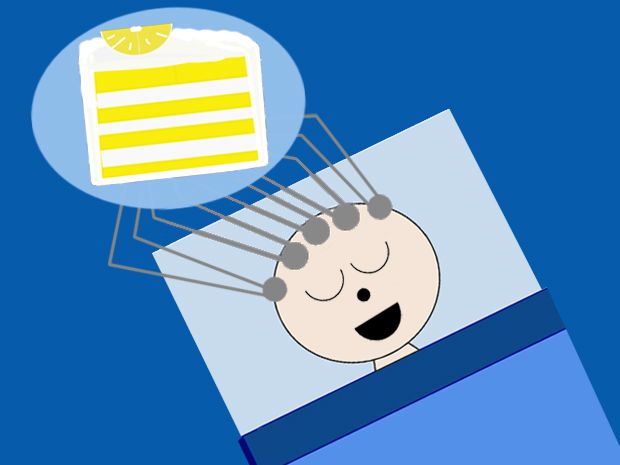Shortly after the original research came out, cognitive neuroscientist Christian Jarrett, writing at his WIRED blog, Brain Watch, posted a serious critique of the research and the conclusions reached.
Too bad - it seemed promising, and maybe it still is when the technology is more refined.
Bagaimana Menarikkan Article Pada Hari Ini . BLUE.Jangan Lupa Datang Lagi Untuk Membaca Article Yang lebih Menarik Pada Masa Akan Datang/Psychologists Give People Control of Their Dreams Using Brain Stimulation. Really?
05.12.14 | By Christian Jarrett
Image: Old Visuals Everett Collection/Getty
My dreams are often like a bad TV night – full of repeats that I’ve slept through many times before. Other people are luckier. Their dreams are more like a movie experience, but one where they not only get to choose the film, they can also take directorial control and influence the course of events. This is known as “lucid dreaming” and considered a half-way house between sleep and wakefulness.
In a study out this week, a team of psychologists led by Ursula Voss at the J.W. Goethe University in Frankfurt, claim to have given non lucid-dreamers the power of lucid dreaming by applying weak electrical current to the surface of their scalps and into their brains.
The rationale behind the study is simple. Past research has associated lucid dreaming with electrical brain activity in the low gamma range – around 40Hz. Voss and colleagues therefore used transcranial alternating current stimulation (tACS) to promote gamma activity in frontal and temporal regions of their participants’ brains, in the hope that this would provoke lucid dreaming (tACS is similar tDCS, which I’ve written about on this blog before).
I have to admit this reasoning tickled my BS-detector a little. Neurobunk research conducted in the 1960s made the mistake of assuming that because experienced meditators exhibit brain activity in the alpha range (around 10Hz), then teaching people to express alpha brainwaves would give them a shortcut to the peace and enlightenment associated with years of meditative practice. It was an elementary case of confusing correlation for causality and results were disappointing.
Despite my initial skepticism, it turns out that, aside from a small sample, this new dream research is well conducted. Voss and her team tested 27 healthy volunteers (15 women, 12 men, none of whom usually have lucid dreams) on four successive nights. Each night, the participants were zapped with electricity in a different frequency range or – and it’s important they included this condition – with no electricity at all (known as a “sham” treatment). The stimulation was delivered after between two and three minutes of uninterrupted REM sleep. Shortly afterwards the participants were woken and they answered questions about the dream they’d just had.
The main result is that stimulation specifically delivered in the low gamma range, at 40Hz, and to a lesser extent at 25Hz, was associated with a greater experience of lucid dreaming, as compared to stimulation at other higher and lower frequencies or to sham treatment. “Our experiment is, to the best of our knowledge, the first to demonstrate altered conscious awareness as a direct consequence of induced gamma-band oscillations during sleep,” the researchers concluded. Excitable headlines have followed, such as “Brain Zap Could Help You Control Your Dreams” and “Having Nightmares? Control Your Dreams With Electric Currents“.
Despite the robust methodology, I think these headlines are getting carried away. Here’s why. Lucid dreaming was defined by higher scores in participants’ feelings of insight (knowing that they were dreaming); dissociation (taking a third person perspective); and control (being able to shape events). I looked up the paper where the researchers first described their scale for measuring these factors. If I understand correctly, the participants rated their experience of these three factors on a scale of 0 (strongly disagree that I had such an experience) to 5 (strongly agree). Now if we look to see the scores they gave for how much dream insight, dissociation and control they had, we find that the averages for the gamma stimulation condition are around 0.6, 1.3, and 0.5 respectively.
Yes, these scores are significantly higher compared with stimulation at other frequencies and with sham treatment, but they are nonetheless incredibly low. A real life creation of the dream control depicted in the movie Inception, this is not! I suppose this study is a proof of principle, so let’s wait and see what comes from future research.
But actually one more thing – these kind of studies that examine the impact of brain stimulation seem so crude. Do the researchers really know what neural effect the stimulation is having and why? I don’t think they do – the explanation in this paper is typically sketchy. “We assume that lower gamma activity is mediated by activation of fast-spiking interneurons that are known to generate gamma oscillations in cortical networks … These networks have been proposed to gate sensory processing, which might also enable lucid dreaming in a temporarily specific manner.” Got that? No, me neither.

 Induction of Self-Awareness in Dreams Through Frontal Low-Current Stimulation of Gamma Activity
Induction of Self-Awareness in Dreams Through Frontal Low-Current Stimulation of Gamma Activity


 2014 Nobel Prize Winners Speak at the University of Arizona
2014 Nobel Prize Winners Speak at the University of Arizona





Posting Komentar
Click to see the code!
To insert emoticon you must added at least one space before the code.